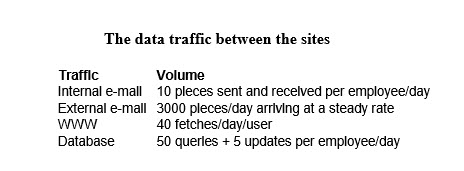Question
1. We assume that XYZ Corporation has three business offices and we want to design a data networks. These offices are in the cities of
1. We assume that XYZ Corporation has three business offices and we want to design a data networks. These offices are in the cities of Atlanta, Boston, and Chicago. We assume that there are 24 employees in Atlanta, 32 employees in Boston, and 18 employees in Chicago. The traffic between the sites is generated by 3 principal applications. They are email, external Web access, and distributed database. We summarize all the traffic involved in the table below. We assume that 20% of the internal e-mail, World Wide Web, and database traffic occurs in the busy hour, while we assume that the external email arrives evenly throughout the day. On average each employee sends and receives 10 pieces of internal e-mail. Internal e-mail is used to circulate presentations, spreadsheets, and memoranda. While the base files are modest, the attachments are large and each piece of mail averages 50,000 bytes. In addition, there are 3000 pieces of e-mail received a day from the outside world (12000 bytes). Each of these necessitates a response. We assume that the external e-mail is evenly distributed among the users and does not have peaks and valleys like the internal traffic. Further, the company uses the WWW to conduct business. Each employee generates an average of 40 external Uniform Resource Locator (URL) requests/day. Each URL request generates an average of 12 small (128-byte) datagrams to set up the transfer, 6 in each direction, and an inbound transfer of a single large (2000-byte) datagram. Finally, the data to run the XYZ Corporation is distributed across 3 servers, 1 at each office. During the day each employee makes an average of 50 queries and 5 updates. The query flows to the first server and then, if the data needed is not local, the query flows to a remote server. The query packets average 600 bytes and the response packets average 3000 bytes. The probability of the data being on any server is 1/3. Unlike the internal e-mail traffic, it is spread evenly among the 3 sites. The updates involve an initial packet averaging 5000 bytes and a response of 500 bytes. 


Step by Step Solution
There are 3 Steps involved in it
Step: 1

Get Instant Access to Expert-Tailored Solutions
See step-by-step solutions with expert insights and AI powered tools for academic success
Step: 2

Step: 3

Ace Your Homework with AI
Get the answers you need in no time with our AI-driven, step-by-step assistance
Get Started


